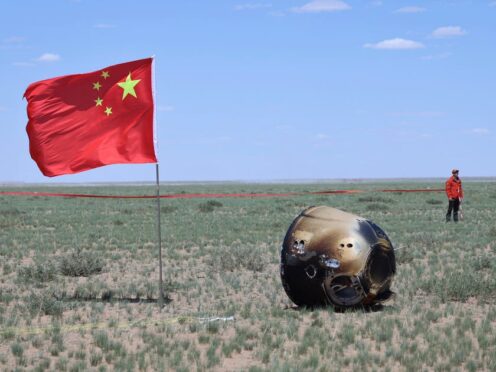
China’s space officials have said they would welcome scientists from around the world to apply to study the lunar rock samples that the Chang’e 6 probe brought back to Earth in a historic mission.
However, they noted there were limits to that co-operation, specifically with the United States.
Officials said at a televised news conference in Beijing meant to introduce the mission’s achievements that any co-operation with the US would be hinged on removing an American law that bans direct bilateral co-operation with Nasa.
“The source of the obstacle in US-China aerospace co-operation is still in the Wolf Amendment,” said Bian Zhigang, vice chair of the China National Space Administration.
“If the US truly wants to hope to begin regular aerospace co-operation, I think they should take the appropriate measures to remove the obstacle.”
The Wolf Amendment was enacted in 2011 and prevents direct US-Chinese bilateral co-operation except in cases where the FBI can certify that there is no national security risk to sharing information with the Chinese side in the course of work.
Still, China could co-operate with scientists from other countries. It worked with the European Space Agency, France, Italy and Pakistan in the Chang’e 6 mission.
“China welcomes scientists from all countries to apply according to the processes and share in the benefits,” said Liu Yunfeng, director of the international co-operation office of the China National Space Administration.
Meanwhile, little information about the global first achieved on Tuesday was announced. Chinese officials declined to reveal how many samples they actually gathered or any preliminary findings.

“I’m afraid this matter will not be revealed until tomorrow, so I hope everyone can wait patiently for another day,” Chang’e 6 chief designer Hu Hao said at the news conference.
On Monday, Chinese scientists said that they anticipate the returned samples will include 2.5 million-year-old volcanic rock and other material that scientists hope will answer questions about geographic differences on the Moon’s two sides.
The near side of the Moon is what is seen from Earth, and the far side faces outer space. The far side is also known to have mountains and impact craters and is much more difficult to reach.
The probe’s journey to the far side of the Moon was historic in that it was the first time a probe had successfully taken off and brought back samples from the far side directly. Previous samples thought to be from the far side of the Moon are from meteorites found on Earth.
The probe had landed in the Moon’s South Pole-Aitken Basin, an impact crater created more than four billion years ago.
The samples scientists are expecting will likely come from different layers of the basin, which will bear traces of the different geological events across its long chronology, such as when the Moon was younger and had an active inside that could produce volcanic rock.
Officials did announce some future plans, with a planned Chang’e 7 probe to explore resources on the Moon’s South Pole.
Further down the line, they have planned Tianwen-3 for around 2030 to carry out a Mars sample return mission and a Tianwen-4 Jupiter exploration mission.

Enjoy the convenience of having The Sunday Post delivered as a digital ePaper straight to your smartphone, tablet or computer.
Subscribe for only £5.49 a month and enjoy all the benefits of the printed paper as a digital replica.
Subscribe